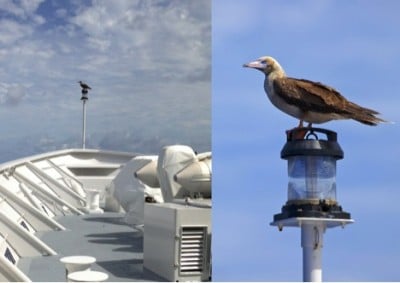Today is transit day. The Golden Shadow is moving from Prony Bay, at the southern end of the main island (Grande Terre) of New Caledonia to Cook Reef in the north. It is a day for all the scientists to catch up on data entry, verify species identifications, process lab samples, and catalogue photographic records.
As we cruise along in smooth seas a hitchhiker joins us; a Red-footed Booby (Sulu sulu) has landed on the bow light. For several hours now this bird has utilized the light as a vantage point to survey the seas and preen. Perhaps spotting for small fish near the surface, it takes flight every couple of hours, swoops down near the water, and circles the ship before returning to its perch. Maybe this seabird is simply taking advantage of the free ride and a safe spot to rest.

A Red-footed Booby hitches a ride on the bow light and surveys the seas as we travel north.
Throughout history these seabirds have been recorded in ships’ logs. The red-footed booby will commonly land aboard sailing ships. In fact, the name ‘booby’ likely comes from the observations of early Spanish explorers calling the birds ‘bobo’ meaning stupid, as they are tame and easy to capture and eat.
Red-footed boobies are long-flight birds, traveling up to 150 kilometers (93 miles) in search of food. This species of seabird does not migrate. It lives year-round in tropical and subtropical regions of the Atlantic, Pacific, and Indian Oceans. The red-footed booby nests on coral atolls or volcanic islands, producing only one egg per clutch once every 15 months; both parents care for the chick. Young birds mature slowly, but the have a lifespan of 20 years or more. These are the smallest of more than half a dozen booby species with a body size ranging from 64 to 76 centimeters (25 to 30 inches) and a wingspan up to 1 meter (3.3 feet).
Boobies are well adapted for diving, their bodies are lean and aerodynamic with long wings that wrap around their body. Just before entering the water these seabirds close their nostrils and cover their eyes with a nictitating membrane, a biological adaptation of most diving birds.
It will be interesting to see how far north this seabird will travel with us. For now though it seems happy just hitching a ride.
Photos: 1 – Dawn Bailey, 2 – Ken Marks